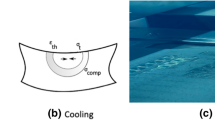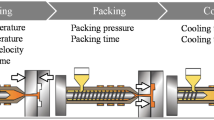Abstract
Family molds can be used to simultaneously produce a variety of parts with different shapes that are made of the same plastic material. Studies on family molds have mostly focused on the layouts of different parts in a mold or the design of runner systems. Cold runners are rarely used in the conformal cooling channel (CCC)-related studies because, under normal circumstances, the mold cavity cooling time should be shortened as much as possible. However, a runner system does the opposite by extending the cooling time to provide sufficient melt and pressure to the mold cavity and ensure high part quality; accordingly, the effect of cold runners was often overlooked in CCC-related studies to reduce variability. In this study, a cooling channel layout design (LD)-based method was developed for the design of a hive-shaped CCC. Moldflow was used to simulate and compare the performance of the channel layouts with horizontal parallel connection, horizontal series connection, vertical parallel connection, and vertical series connection. The performance of the proposed hive-shaped CCCs was also compared with an SCC and a honeycomb CCC. The results of this study verified that the proposed LD-based method can be used to establish a hive-shaped CCC automatically. Compared with other CCCs, the established hive-shaped CCC provides stronger support to the mold cavity, shortens the cooling cycle, and improves part quality.





















Similar content being viewed by others
Data availability
Data will be made available on request.
References
Lin TW, Huang CT, Lin TW, Jong WR, Chen SC (2021) A methodology to predict and optimize ease of assembly for injected parts in a family-mold system. Polym 13:3065
Park HP, Rhee BO, Cha BS (2006) Variable-runner system for family mold filling balance. Solid State Phenom 116:96–101
Chan IW, Pinfold M, Kwong C, Szeto W (2011) A review of research, commercial software packages and patents on family mould layout design automation and optimisation. Int J Adv Manuf Technol 57:23–47
Chan IWM, Pinfold M, Kwong CK, Szeto WH (2014) Automation and optimisation of family mould cavity and runner layout design (FMCRLD) using genetic algorithms and mould layout design grammars. Comput Aided Des 47:118–133
Huang WT, Tasi ZY, Ho WH, Chou JH (2022) Integrating Taguchi method and gray relational analysis for auto locks by using multiobjective design in computer-aided engineering. Polym 14:644
Lu CT, Chen CH, Tseng SC (2019) Application of conformal cooling to reduce cooling time and warpage of a U-shaped plate. In: The 34th International Conference of the Polymer Processing Society, Taipei. https://www.semanticscholar.org/paper/Application-of-conformal-cooling-to-reduce-cooling-Lu-Chen/f1e3ff04724daf1013a05e57eadd3b6cb7c21386
Güldaş A, Göktaş M (2019) Comparison of straight, spiral conformal and zigzag conformal cooling channels in plastic injection molds. In: 3nd International Symposium on Innovative Approaches in Scientific Studies, Tarkey. https://scholar.google.com.tr/citations?view_op=view_citation&hl=tr&user=zi7Rp5sAAAAJ&citation_for_view=zi7Rp5sAAAAJ:NMxIlDl6LWMC
Goktas M, Guldas A (2020) Production of plastic injection molds with conformal cooling channels by laminated brazing method. J Sci 33:780–789
Muvunzi R, Dimitrov DM, Matope S, Harms T (2021) A case study on the design of a hot stamping tool with conformal cooling channels. Int J Adv Manuf Technol 114:1833–1846
Abelardo TA, Manuel JMC, De Dios JCG, Cristina MD (2021) A hybrid cooling model based on the use of newly designed fluted conformal cooling channels and fastcool inserts for green molds. Polym 13:3115
Manuel JMC, Abelardo TA, Javier CR, Cristina MD (2021) A new conformal cooling system for plastic collimators based on the use of complex geometries and optimization of temperature profiles. Polym 13:2744
Abelardo TA, Manuel JMC, De Dios JCG, Cristina CD (2021) Application of new triple hook-shaped conformal cooling channels for cores and sliders in injection molding to reduce residual stress andwarping in complex plastic optical parts. Polym 13:2944
Andreas K, Yogeshkumar K, Livia Z, Frank E, Curdin W (2021) Dynamic conformal cooling improves injectionmolding. Int J Adv Manuf Technol 114:107–116
Philipp JW, Jens N, Robert B, Jorg H, Stefan K (2022) Design of additively manufacturable injection molds with conformal cooling. In: in 12th CIRP Conference on Phoyonic Technologies, Fürth, Germany. https://www.sciencedirect.com/science/article/pii/S2212827122010320
Chang HJ, Zhang GG, Sun Y, Lu SH (2022) Using sequence-approximation optimization and radial-basis-function network for brake-pedal multi-target warping and cooling. Polym 14:2578
Abelardo TA, Manuel JMC, De Dios JCG, Cristina MD (2023) Application of new conformal cooling layouts to the green injection molding of complex slender polymeric parts with high dimensional specifications. Polym 15:558
Li CL, Li CG, Mok ACK (2005) Automatic layout design of plastic injection mould cooling system. Comput Aided Des 37:645–662
Wang Y, Yu KM, Wang CCL, Zhang YB (2011) Automatic design of conformal cooling circuits for rapid tooling. Comupter-Aided Design 43:1001–1010
Luh YP, Wang HL, Iao HW, Kuo TC (2019) Using hotspot analysis to establish non-equidistant cooling channels automatically. J Chin Inst Eng 42:690–699
Li CG, Li CL (2008) Plastic injection mould cooling system design bt the configuration space method. Comput Aided Des 40:334–349
Au KM, Yu KM, Chiu WK (2011) Visibility-base conformal cooling channel generation for rapid tooling. Comput Aided Des 43:356–373
Homar D, Pušavec F (2016) The development of a recognition geometry algorithm for hybrid – subtractive and additive manufacturing. J Mech Eng 63:151–160
Sachs E, Allen S, Guo H, Banos J, Cima M, Serdy J, Brancazio D (1997) Progress on tooling by 3D printing; conformal cooling, dimensional control, surface finish and hardness. In: International Solid Freeform Fabrication Symposium. https://www.semanticscholar.org/paper/Progress-on-Tooling-by-3D-Printing%3B-Conformal-and-Sachs-Allen/779099ee7c1afa53a1d328e90dc3865c80cc4f82
Au KM, Yu KM (2006) Variable radius conformal cooling channel for rapid tool. Mater Sci Forum 532:520–523
Saifullah ABM, Masood SH (2007) Optimum cooling channels design and thermal analysis of an Injection moulded plastic part mould. Mater Sci Forum 561:1999–2002
Park HS, Pham NH (2009) Design of conformal cooling channels for an autmotice part. Int J Automot Technol 10:87–93
J.H. Choi, J.S. Kim, E.S. Han, H.P. Park and B.O. Rhee, "Study on an optimized configuration of conformal cooling channel by branching law," in Proceedings of the ASME 2014 12th Biennial Conference on Engineering Systems Design and Analysis, Copenhagen, Denmark, 2014. https://link.springer.com/article/10.1007/s12239-009-0011-7
Sabrina M, Adriano FS, Jackson M, Ihar Y (2015) Design of conformal cooling for plastic injection moulding by heat transfer simulation. Polimeros 25:564–574
Košík M, Bílik J, Šuba R (2016) Design of injection mould with conformal cooling using numerical modelling. Acta Tech Corviniensis-Bull Eng 3:19–26
Hu P, He B, Ying L (2016) Numerical investigation on cooling performance of hot stamping tool with various channel design. Appl Therm Eng 96:338–351
Li Z, Wang XY, Gu JF, Ruan SL, Shen CY, Lyu Y, Zhao Y (2018) Topology optimization for the design of conformal cooling system in thin-wall injection molding based on BEM. Int J Adv Manuf Technol 94:1041–1059
Ognen T, Atanas K (2018) Conformal cooling channels in injection molding tools design considerations. Int Sci J Mach Technol Mater 12:445–448
Kuo CC, Jiang ZF, Yang MX, You BJ, Zhong WC (2021) Effects of cooling channel layout on the cooling performance of rapid injection mold. Int J Adv Manuf Technol 114:2697–2710
Sílvia B, Ricardo E, Diogo L (2022) Automatic generation of conformal cooling channels in injection moulding. Comput Aided Des 150:103312
Choi JH, Gim J, Rhee B (2023) A novel design method of an evolutionary mold cooling channel using biomimetic engineering. Polym 15:798
Kuo CC, Xu YX (2022) A simple method of improving warpage and cooling time of injection molded parts simultaneously. Int J Adv Manuf Technol 122:619–637
Luh YP, Chin CC, Iao HW (2023) Automated design of honeycomb conformal cooling channels for improving injection molding quality. Prod Eng Arch 29:44–57
Code availability
Not applicable (only commercial software was used).
Author information
Authors and Affiliations
Contributions
Conceptualization: Yuan-Ping Luh, Huang-Li Wang; investigation: Huang-Li Wang, Hong-Wai Iao; formula derivation: Yuan-Ping Luh, Huang-Li Wang; visualization: Hong-Wai Iao; simulation: Hong-Wai Iao; writing—original draft preparation: Huang-Li Wang; writing—review and editing: Yuan-Ping Luh.
Corresponding author
Ethics declarations
Ethics approval
Not applicable.
Consent to participate
Not applicable.
Consent for publication
All authors read and agreed to the published version of the manuscript.
Competing interests
The authors declare no competing interests.
Additional information
Publisher’s note
Springer Nature remains neutral with regard to jurisdictional claims in published maps and institutional affiliations.
Rights and permissions
Springer Nature or its licensor (e.g. a society or other partner) holds exclusive rights to this article under a publishing agreement with the author(s) or other rightsholder(s); author self-archiving of the accepted manuscript version of this article is solely governed by the terms of such publishing agreement and applicable law.
About this article
Cite this article
Luh, YP., Wang, HL. & Iao, HW. Effect of the layout design of hive-shaped conformal cooling channels on the deflection of family molds. Int J Adv Manuf Technol 128, 1179–1198 (2023). https://doi.org/10.1007/s00170-023-12021-9
Received:
Accepted:
Published:
Issue Date:
DOI: https://doi.org/10.1007/s00170-023-12021-9




